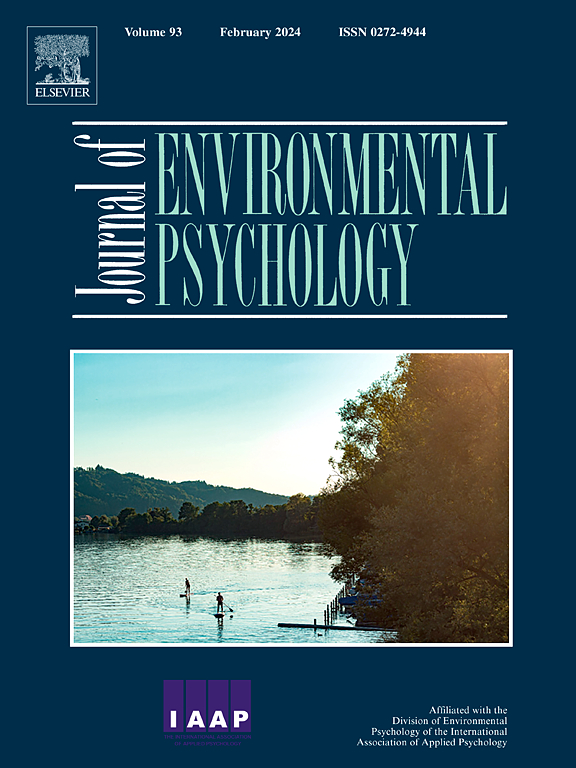Good city and nice people: The impact of the perceived built environment on prosocial tendencies, flourishing, depression, and anxiety
IF 6.1
1区 心理学
Q1 ENVIRONMENTAL STUDIES
引用次数: 0
Abstract
Numerous studies have reported that the built environment plays a key role in promoting prosocial behaviors. However, to date, the potential positive psychological mechanisms underlying the association between built environment and prosocial behaviors in urban adult residents have not been well examined. To fill this research gap, the present study explored the mediation pathway from the perceived built environment to prosocial tendencies from a positive psychology perspective. Moreover, the present study focused on the moderating effects of depression and anxiety on this mediation pathway. A sample of 1150 urban community-dwelling adults completed questionnaires that assessed the perceived built environment, flourishing, prosocial tendencies, depression symptoms, and severity of anxiety. The results of the mediation model analysis demonstrated that the positive effect of perceived built environment on prosocial tendencies was partially mediated by flourishing. Furthermore, using a moderated mediation model analysis, we found that depression and anxiety moderated the link between perceived built environment and prosocial tendencies via flourishing. More specifically, the effect of the perceived built environment on flourishing was stronger for residents who experienced high levels of depression and anxiety than for those who experienced low levels of depression and anxiety. Additionally, we found that depression and anxiety moderated the mediating effect of flourishing. Compared with residents without a risk of depression and anxiety, individuals experiencing high levels of depression and anxiety obtained more psychosocial benefits derived from the high quality of the built environment. Overall, these findings provide an empirical contribution to the human-environment interaction research field and increase the precision of urban-based interventions and policies for the promotion of human well-being in urban contexts.
好城市和好人:可感知的建筑环境对亲社会倾向、蓬勃发展、抑郁和焦虑的影响
大量研究表明,建筑环境在促进亲社会行为方面发挥着关键作用。然而,迄今为止,城市成年居民的建筑环境与亲社会行为之间潜在的积极心理机制尚未得到很好的研究。为了填补这一研究空白,本研究从积极心理学的角度探讨了从感知建筑环境到亲社会倾向的中介途径。此外,本研究还关注了抑郁和焦虑对这一中介途径的调节作用。1150名居住在城市社区的成人样本填写了调查问卷,对感知的建筑环境、蓬勃发展、亲社会倾向、抑郁症状和焦虑严重程度进行了评估。中介模型分析的结果表明,感知到的建筑环境对亲社会倾向的积极影响部分是由蓬勃发展中介的。此外,通过调节中介模型分析,我们发现抑郁和焦虑通过兴旺调节了感知到的建筑环境与亲社会倾向之间的联系。更具体地说,与抑郁和焦虑程度低的居民相比,抑郁和焦虑程度高的居民感知到的建筑环境对繁荣程度的影响更大。此外,我们还发现抑郁和焦虑对繁荣的中介效应有调节作用。与没有抑郁和焦虑风险的居民相比,抑郁和焦虑程度高的人从高质量的建筑环境中获得了更多的社会心理益处。总之,这些发现为人类与环境互动研究领域做出了实证贡献,并提高了基于城市的干预措施和政策的精确性,以促进城市环境中的人类福祉。
本文章由计算机程序翻译,如有差异,请以英文原文为准。
求助全文
约1分钟内获得全文
求助全文
来源期刊

Journal of Environmental Psychology
Multiple-
CiteScore
10.60
自引率
8.70%
发文量
140
审稿时长
62 days
期刊介绍:
The Journal of Environmental Psychology is the premier journal in the field, serving individuals in a wide range of disciplines who have an interest in the scientific study of the transactions and interrelationships between people and their surroundings (including built, social, natural and virtual environments, the use and abuse of nature and natural resources, and sustainability-related behavior). The journal publishes internationally contributed empirical studies and reviews of research on these topics that advance new insights. As an important forum for the field, the journal publishes some of the most influential papers in the discipline that reflect the scientific development of environmental psychology. Contributions on theoretical, methodological, and practical aspects of all human-environment interactions are welcome, along with innovative or interdisciplinary approaches that have a psychological emphasis. Research areas include: •Psychological and behavioral aspects of people and nature •Cognitive mapping, spatial cognition and wayfinding •Ecological consequences of human actions •Theories of place, place attachment, and place identity •Environmental risks and hazards: perception, behavior, and management •Perception and evaluation of buildings and natural landscapes •Effects of physical and natural settings on human cognition and health •Theories of proenvironmental behavior, norms, attitudes, and personality •Psychology of sustainability and climate change •Psychological aspects of resource management and crises •Social use of space: crowding, privacy, territoriality, personal space •Design of, and experiences related to, the physical aspects of workplaces, schools, residences, public buildings and public space
 求助内容:
求助内容: 应助结果提醒方式:
应助结果提醒方式:


